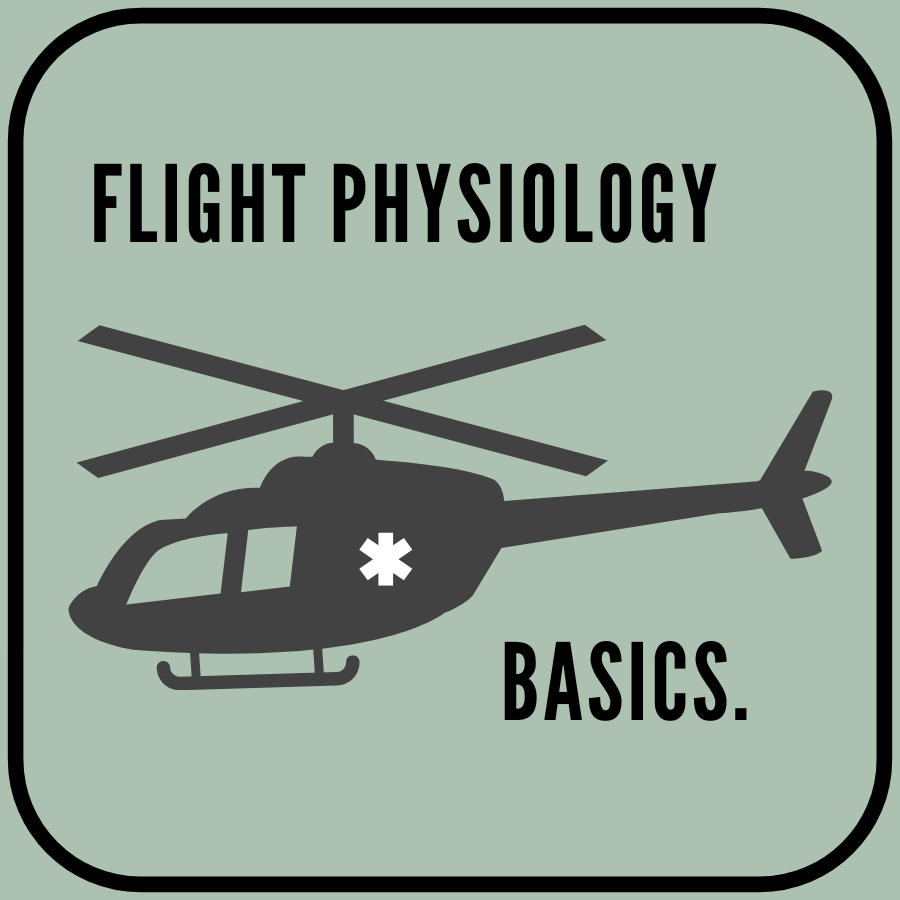Your cart is currently empty!

Flight Physiology Basics
Posted by:
|
On:
|
Flight Physiology Basics
The aircraft doesn’t change everything, but the things it can change are pretty technical. The altitude, the pressure, the vibration, the noise, the environment—it all affects you and your patient in ways you might not expect.
Flight physiology is one of those things that seems super technical until you’re mid-air watching your patient desaturate and realizing altitude just turned a stable ground transport into a critical event.
Here’s what every provider stepping into the skies—or working closely with air crews—should understand about how flight affects human physiology.
Boyle’s Law: Gas Expands as Pressure Drops
The higher we go, the lower the atmospheric pressure. That means trapped gases in the body (or equipment) expand.
Why it matters:
- Pneumothorax can worsen mid-flight. Even a small, undrained pneumo on the ground can become life-threatening in the air.
- Gastric expansion can lead to vomiting or aspiration risks.
- ETT cuffs and IV bags can overinflate—always monitor and adjust!
- Equipment with gas-filled spaces (like air splints or BVM reservoirs) may expand or burst if not vented properly.
Dalton’s Law: Less Oxygen Up High
As altitude increases, the percentage of oxygen stays the same (21%), but the partial pressure of oxygen drops. That means less O2 available for gas exchange.
Why it matters:
- Even healthy patients may show lower SpO2 at altitude.
- Hypoxic patients on the ground might desaturate quickly in the air—even on oxygen.
- You might need to increase FiO2 or switch to positive pressure ventilation to maintain oxygenation.
Henry’s Law: Dissolved Gases Come Out
This one’s important for diving-related injuries (like decompression sickness), but it also reminds us that changing pressure can affect how gases behave in the bloodstream.
Why it matters:
- Patients with air embolisms or recent diving injuries shouldn’t be flown without decompression precautions
- Flight may worsen air-related vascular issues.
Thermal Stress: It’s Cold Up There
Aircraft cabins aren’t always climate-controlled, and temperatures drop with altitude.
Why it matters:
- Hypothermia is a real risk, especially for trauma patients.
- Always bundle your patient appropriately—even if they feel warm on the ground.
- You’re not immune either—layer up, especially on night shifts or long transports.
Noise, Vibration, and Motion: Sensory Overload
It’s loud. It shakes. It’s tight. And it doesn’t stop.
Why it matters:
- You’ll miss breath sounds. Use ETCO2 and visual chest rise to confirm ventilations.
- Communication can be tough—have clear signals and confirm your plan before takeoff.
- Motion sickness is real—for patients and providers. Bring Zofran. Trust me.
Stress and Fatigue: Flight Isn’t Just Physically Demanding
Cognitive load increases at altitude. You’re working harder, thinking faster, and fighting the elements. Add in adrenaline, patient acuity, and the fact that you might be 30 minutes from the nearest trauma center—it’s a lot.
What helps:
- Have a solid preflight routine.
- Practice crew resource management (CRM).
- Don’t underestimate the importance of hydration, rest, and nutrition—on shift and off.
Final Thought: The Air Changes the Game—Train for It
Flight physiology isn’t just theory. It’s the difference between a smooth transport and a mid-air emergency. Understanding how the body reacts at altitude helps you anticipate problems before they escalate.
So whether you’re prepping for your first shift on flight status or just brushing up on your critical care knowledge, remember: once the rotors spin up, the rules change.
Prepare accordingly. Respect the physiology. And keep flying smart.